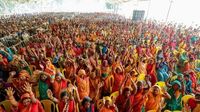As the final phase of the 2025 Bihar Assembly elections approaches, the state is abuzz with anticipation and political fervor. With polling for 122 assembly constituencies across 20 districts set for November 11, the stakes couldn’t be higher. The outcome will not only determine the fate of 1,302 candidates—including 1,165 men, 136 women, and one third gender candidate—but also shape Bihar’s political landscape for the next five years, according to reports from Times of India and Hindustan Times.
The first phase of voting, held on November 6 across 121 constituencies in 18 districts, set the tone for these high-stakes elections. The Chief Electoral Officer announced a record voter turnout of 65.08%, the highest in the state’s history and a significant jump from both the 2020 Assembly elections and the 2024 Lok Sabha polls. Women, in particular, turned out in large numbers across 45,341 polling stations, underscoring the growing engagement of female voters in Bihar’s democratic process. Prime Minister Narendra Modi, addressing a rally in Sitamarhi, called this surge in participation a “65-volt jhatka to jungle raj,” referencing the opposition’s past governance, according to Times of India.
The second and final phase will see voters from districts such as West Champaran, East Champaran, Sitamarhi, Shivhar, Madhubani, Supaul, Araria, Kishanganj, Purnia, Katihar, Bhagalpur, Banka, Jamui, Nawada, Gaya, Aurangabad, Jehanabad, Arwal, Kaimur, and Rohtas heading to the polls. The regions of Seemanchal and Champaran, dominated by Muslim and backward caste voters, and the diverse Magadh and Shahabad belts, are expected to be battlegrounds where every vote counts. Key leaders in this round include Vijay Kumar Khemka (Purnia), Avidur Rahman (Araria), Sweety Singh (Kishanganj), Tarkishore Prasad (Katihar), Bijendra Prasad Yadav (Supaul), Prem Kumar (Gaya), and Shreyasi Singh (Jamui).
The campaign trail has been nothing short of electric. The National Democratic Alliance (NDA) and the Grand Alliance (INDIA bloc) have unleashed their top leaders in a last-ditch effort to sway undecided voters. Prime Minister Modi, in rallies at Bhagalpur and Araria, did not mince words, lambasting the Rashtriya Janata Dal (RJD) for what he described as “lawlessness and stagnation,” and urging voters to reject the party for Bihar’s progress. “First phase voter turnout in Bihar polls is 65-volt 'jhatka' to jungle raj,” he declared, positioning the NDA as the force for stability and development.
BJP National President Jagat Prakash Nadda echoed these sentiments at rallies in East and West Champaran and Madhubani, accusing the RJD of plunging Bihar into “chaos and darkness” during its rule. He credited the NDA government for visible progress in infrastructure—highways, internet connectivity, railways, and airports—calling these the hallmarks of Bihar’s transformation. Chief Minister Nitish Kumar, meanwhile, has been tirelessly touring Araria, Katihar, and Kishanganj, highlighting his government’s achievements and calling on voters to reaffirm their trust in the NDA. “Now is the time to place Bihar in the category of the most developed states,” Nitish Kumar wrote on social media, congratulating voters on the record turnout.
Defence Minister Rajnath Singh and Uttar Pradesh Chief Minister Yogi Adityanath have also been active on the campaign trail. Singh, speaking in Jamui and Banka, accused the Grand Alliance of misleading voters with hollow promises. Yogi Adityanath, at rallies in Motihari, Pipra, and Attari on November 8, used vivid analogies, stating, “Bihar wants to shine not in the dim light of the lantern but in the bright LED light of NDA rule,” referencing the RJD’s election symbol. He emphasized the NDA’s “zero-tolerance policy against crime, criminals, Naxalism, and Maoism,” and drew parallels with Uttar Pradesh’s crackdown on organized crime, saying, “When the bulldozer moves, the mafia’s backbone breaks.” He predicted a decisive NDA victory, asserting, “When the EVMs are opened on November 14, the people’s verdict will be clear—Phir Ek Baar NDA Sarkar.”
The opposition, however, has mounted a spirited challenge. Congress leader Priyanka Gandhi Vadra, campaigning in Valmikinagar and Chanpatia, accused the NDA of betraying public trust and running Bihar “by remote control,” diminishing the state’s autonomy. She criticized the government’s track record on women’s safety and employment, stating, “Nitish Kumar, who has served as Chief Minister for the past 20 years, has not improved the lives of women, who continue to face hardships.” Tejashwi Prasad Yadav of the RJD reaffirmed the unity of the INDIA bloc, promising change, hope, and inclusive growth. Akhilesh Yadav of the Samajwadi Party and Dipankar Bhattacharya of the CPI(ML) have also been rallying support, focusing on social justice and employment generation.
The campaign has not been without controversy. Congress President Mallikarjun Kharge dismissed NDA’s claims of victory as “unfounded,” while Congress leader Pawan Khera accused the Election Commission of manipulating voter lists. Meanwhile, Jan Suraaj founder Prashant Kishor criticized the BJP-led central government for prioritizing Gujarat over Bihar in industrial development, questioning, “Do you want 'Lalu ka Lalten'? Jungle Raj of Lalten? Now, if you don't vote for Lalu, Nitish, or Modi, then who is left?”
Political analysts see this final phase as a critical test for Bihar's shifting political equilibrium. Both the NDA and the Grand Alliance are fiercely defending their strongholds while making aggressive inroads into each other's territories. The high voter turnout, particularly among women, has added an unpredictable element to the contest. Deputy Chief Minister Keshav Prasad Maurya, brimming with confidence, claimed the NDA could secure up to 85% of the votes, while the Mahagathbandhan might be "fortunate" to get even 15%. “We have no doubt that we will repeat the 2010 results in 2025... NDA will also benefit in the voting of the second phase,” he told ANI.
Yet, the opposition remains optimistic. Mahagathbandhan deputy chief minister Mukesh Sahani pointed out that despite increased percentages, the voting pattern remains unchanged. “Let NDA be happy after seeing the voting percentage for a few days. Let them be happy. However, the voting percentage has not increased; the pattern remains the same as before. With at least 20 thousand votes cut in each constituency, accounting for that, has the percentage increased? Let them (NDA) burst crackers for a few days.”
As Bihar prepares for the final day of polling on November 11, the outcome remains uncertain. The results, to be announced on November 14, will reveal whether the state chooses continuity under the NDA or opts for change with the Grand Alliance. With record voter turnout, fiery rhetoric, and high-profile candidates, Bihar’s 2025 elections are shaping up to be a landmark moment in the state’s democratic journey.






